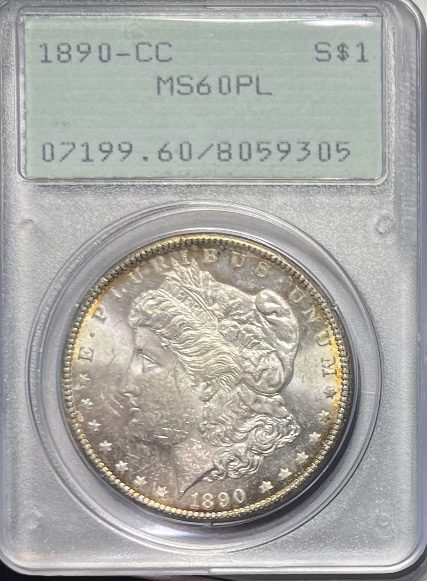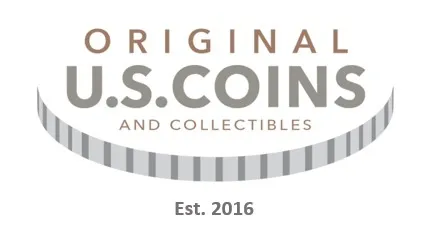A Coin Collector’s Journey – Coin Storage & Grading
One of the best aspects of being a coin dealer is finding, reviewing, and purchasing a coin collection. This is magnified when that collection was put together a long, long time ago, and I’m hearing the history of the collection firsthand and seeing how it was stored and catalogued. Please join me as we start a Coin Collector’s Journey and discuss coin storage and grading.
The techniques used to catalogue, store and display coins provide insight into the history of a coin. Some holders may have writing on them, often by the coin collector him or herself, which can provide a snippet of that collector’s perspective. The holder may contain the date and mintmark of the coin, maybe the denomination, its value and if you were lucky, where and when the coin was purchased and for how much. Many times, the collector places a value on the coin too, adding valuable historical documentation.
Finding those yesteryear methods of storage usually meant the coins were long ago put away. Coin storage products have changed – even “2×2’s”, which are small cardboard frames, white in color with a thin film of plastic to protect the coin while still allowing viewing and then stapled in place, were not always 2” x 2”, were not always white and they were not always stapled together. Many collectors have their “preferred” method of storage, and it is worth researching and reading up the options before committing to one, because storage is an important investment that will protect your collection. Discussing options with other collectors is also a worthy use of your time – whether at coin shows, a local coin shop or online.
One way to store coins, is to have all or some of them certified or graded. An assigned grade to any coin is, and likely will be for the foreseeable future, assigned by a human. Technology has come a long way, but as of this writing, no machine has been able to identify eye appeal. Yes, color, wear and luster are objective enough that a computer can at least aid in defining and assigning a criterion to compare one coin against another, but eye appeal is still a human factor. In fact, even amongst us humans, eye appeal is still an opinion.
Higher states of preservation for a coin can often lead one to decide to have the coin certified or graded by one of the major grading services – PCGS, NGC, ANACS or CACG. Like storage methods, coin collectors also have their “preferred” grading company (more about these grading companies in an upcoming Blog). Condition itself doesn’t always equate to a coin’s certain path to certification. If it did, all newly minted coins today would maybe end up certified. No, even coins that have age and condition quality don’t always get certified. It’s not a free service, so coins of minimal value often are bought and sold without certifying. At coin shows, I often have conversations with collectors about whether to certify a coin or not. Finding coins worthy of certification is a fun way to collect as there are millions of coins that exist in the wild (raw and uncertified) that are just waiting to be discovered.
The biggest factor in deciding to certify a coin is marketability after the coin has been authenticated and graded. Coin buyers like value and grading a coin provides a more defined set of value for a coin. Sometimes for example, a coin graded MS65 versus the same date or coin issue in MS64 can mean thousands of dollars more in market value. IN MANY cases, hundreds of thousands of dollars – so it matters.
Many fakes or counterfeits exist too. Some are obvious, some are not. Certification provides confidence to buyers that the coin is real. Varieties, mint errors and pedigree can all be captured on a certification label which is valuable information for collectors. As a bonus, the certification holder provides protection against the elements and an easy way to store valuable coins.
Here are my thoughts on storage:
My certified coins are easy because the holders are perfect protection for the coins. I store my holders in PCGS or NGC boxes by type and then date – commemoratives, circulated commemoratives, dollars, quarters, and such. It allows me to quickly know if I have a duplicate so that I can decide if I want to keep one or both of the coins.
A recent wrench in my system is that the new CAC holders don’t fit in the PCGS or NGC boxes. I’m hoping that they correct this, or I’ll have to find a new storage system for my certified coins. Way back when Rattlers were smaller than other certified coin holders, inserts were created so they fit snugly, but this is the opposite situation – where the holders don’t fit in my current boxes.
Albums store coins quite well. I’m not a fan of the albums that don’t have the glass slides where you can look at both sides of the coins. These albums have a tendency to darken the reverse more than the obverse, which creates an unbalanced toning situation, in my mind. I prefer Dansco blue or brown glassine holders for album coins.
For special coins that are not certified, I like the Capital plastic holders that have little plastic screws so that my special coins can be shown off in those holders. To see examples of these holders, check out their site. https://www.capitalplastics.com/
I’m not a fan of old PVC flips from the 1970s and 1980s. These flips can cause PVC damage where the PVC leaches from the plastic into the surface of the coin. Non-PVC flips, in general, are fine for short-term storage, but are not designed for long-term storage. Harder plastic non-PVC flips are better for storage, so I avoid the softer flips as those usually have PVC. An easy way to tell if you have the PVC holders – bunch them up and if they smell like a shower curtain – they have PVC.
I am a fan of envelopes for coin storage. Generally, they will protect the coin and have a tendency to leave very attractive toning if left for no longer than a 10-15 year time period. When left longer in envelopes, the coin may get pretty dark, which isn’t always attractive.
One very important note on storage – whatever method you choose, make sure your coin storage area is controlled environmentally, because a wet or damp environment is the worst thing for any coin. Dry conditions with a low humidity environment is just as important as the holder you choose.
There is no “one answer” for storing and grading coins. Taking the time to research and decide how you want to store your coins (and whether or not to have them graded) is a big part of coin collecting – not as much excitement as the hunt, but definitely worth your time.
In my next Blogs, we’ll look at places you can go to add to your coin collection and take a deeper dive into the certification process to grade a coin. Until then, happy collecting and storage!
Michael

